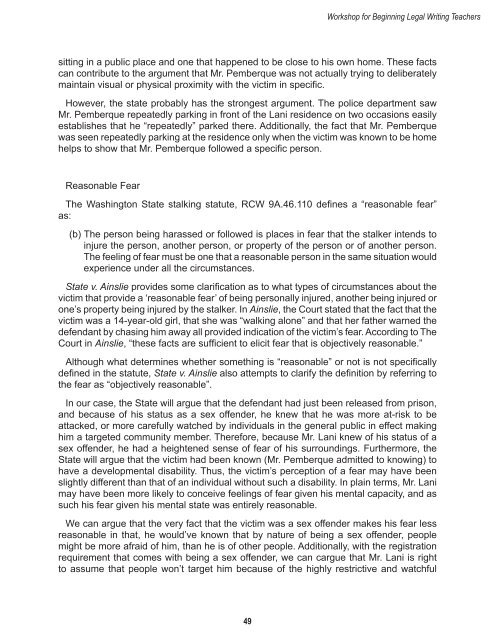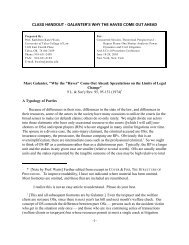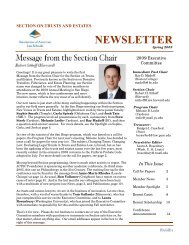Workshop for Beginning Legal Writing Teachers - AALS
Workshop for Beginning Legal Writing Teachers - AALS
Workshop for Beginning Legal Writing Teachers - AALS
Create successful ePaper yourself
Turn your PDF publications into a flip-book with our unique Google optimized e-Paper software.
49<br />
<strong>Workshop</strong> <strong>for</strong> <strong>Beginning</strong> <strong>Legal</strong> <strong>Writing</strong> <strong>Teachers</strong><br />
sitting in a public place and one that happened to be close to his own home. These facts<br />
can contribute to the argument that Mr. Pemberque was not actually trying to deliberately<br />
maintain visual or physical proximity with the victim in specific.<br />
However, the state probably has the strongest argument. The police department saw<br />
Mr. Pemberque repeatedly parking in front of the Lani residence on two occasions easily<br />
establishes that he “repeatedly” parked there. Additionally, the fact that Mr. Pemberque<br />
was seen repeatedly parking at the residence only when the victim was known to be home<br />
helps to show that Mr. Pemberque followed a specific person.<br />
Reasonable Fear<br />
The Washington State stalking statute, RCW 9A.46.110 defines a “reasonable fear”<br />
as:<br />
(b) The person being harassed or followed is places in fear that the stalker intends to<br />
injure the person, another person, or property of the person or of another person.<br />
The feeling of fear must be one that a reasonable person in the same situation would<br />
experience under all the circumstances.<br />
State v. Ainslie provides some clarification as to what types of circumstances about the<br />
victim that provide a ‘reasonable fear’ of being personally injured, another being injured or<br />
one’s property being injured by the stalker. In Ainslie, the Court stated that the fact that the<br />
victim was a 14-year-old girl, that she was “walking alone” and that her father warned the<br />
defendant by chasing him away all provided indication of the victim’s fear. According to The<br />
Court in Ainslie, “these facts are sufficient to elicit fear that is objectively reasonable.”<br />
Although what determines whether something is “reasonable” or not is not specifically<br />
defined in the statute, State v. Ainslie also attempts to clarify the definition by referring to<br />
the fear as “objectively reasonable”.<br />
In our case, the State will argue that the defendant had just been released from prison,<br />
and because of his status as a sex offender, he knew that he was more at-risk to be<br />
attacked, or more carefully watched by individuals in the general public in effect making<br />
him a targeted community member. There<strong>for</strong>e, because Mr. Lani knew of his status of a<br />
sex offender, he had a heightened sense of fear of his surroundings. Furthermore, the<br />
State will argue that the victim had been known (Mr. Pemberque admitted to knowing) to<br />
have a developmental disability. Thus, the victim’s perception of a fear may have been<br />
slightly different than that of an individual without such a disability. In plain terms, Mr. Lani<br />
may have been more likely to conceive feelings of fear given his mental capacity, and as<br />
such his fear given his mental state was entirely reasonable.<br />
We can argue that the very fact that the victim was a sex offender makes his fear less<br />
reasonable in that, he would’ve known that by nature of being a sex offender, people<br />
might be more afraid of him, than he is of other people. Additionally, with the registration<br />
requirement that comes with being a sex offender, we can cargue that Mr. Lani is right<br />
to assume that people won’t target him because of the highly restrictive and watchful







